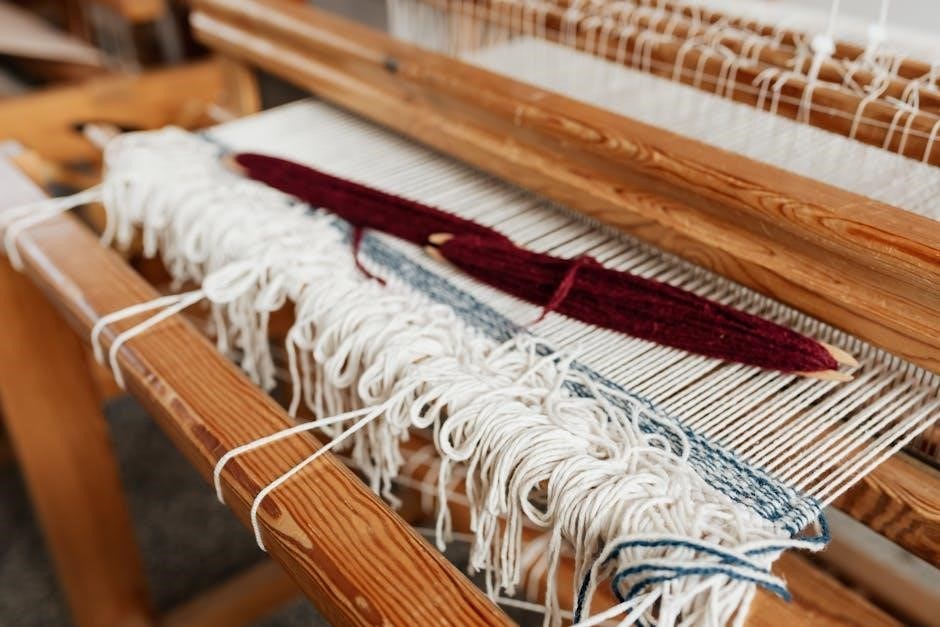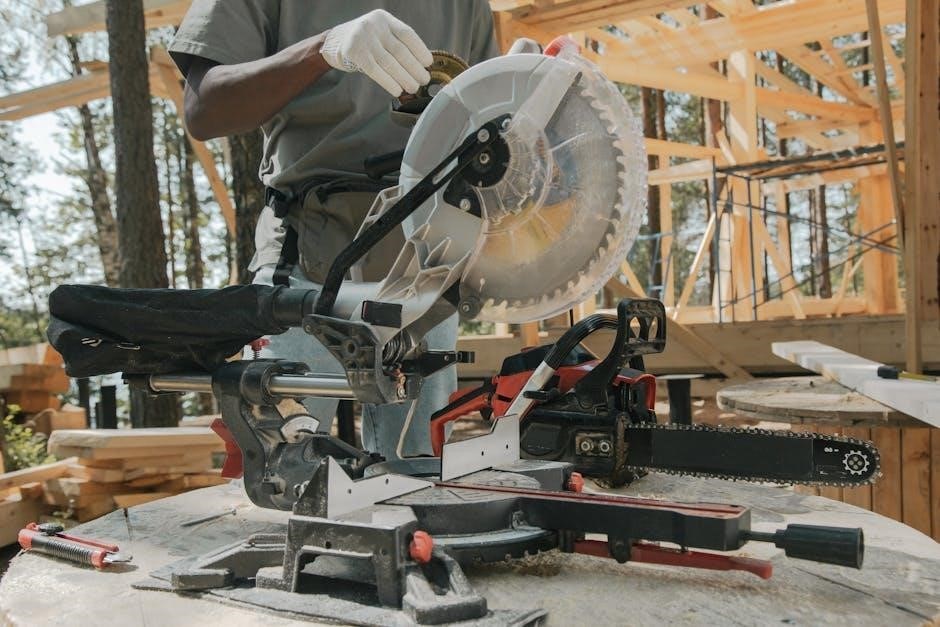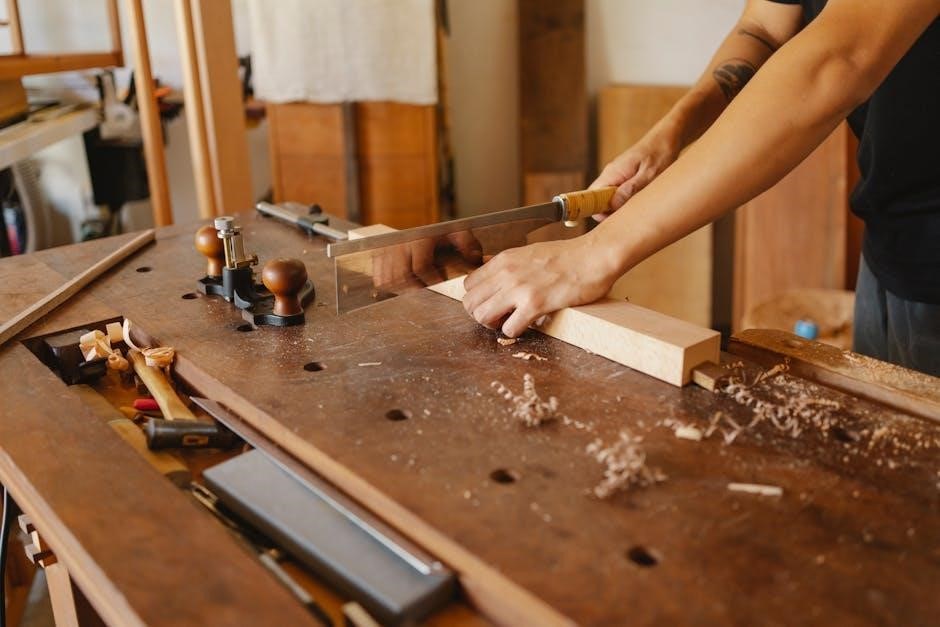The Craftsman 18 42cc Chainsaw is a reliable tool for cutting tasks, featuring a 42cc engine and 18-inch bar. This guide provides essential information for understanding its parts, maintenance, and troubleshooting, ensuring optimal performance and safety.
1.1 Overview of the Model and Its Features
The Craftsman 18 42cc Chainsaw is a gas-powered tool designed for medium-duty cutting tasks. It features a 42cc full-crank engine, delivering steady power for consistent performance. The chainsaw includes an 18-inch low-kickback bar and chain, reducing vibration and improving user control. Weighing approximately 20 pounds, it is maneuverable for various cutting jobs. The model also includes a side-access chain tensioner for easy adjustments and a carry case for convenient storage. Known for its reliability, this chainsaw is ideal for homeowners and professionals needing a durable tool for logging, pruning, or firewood preparation. Its robust design ensures long-term performance with proper maintenance.
1.2 Importance of the Parts Manual
The parts manual for the Craftsman 18 42cc Chainsaw is essential for understanding and maintaining the tool. It provides detailed diagrams and descriptions of all components, ensuring proper identification for repairs or replacements. The manual includes troubleshooting guides, repair instructions, and specifications for manufacturer-approved parts. By referencing the manual, users can ensure safety, performance, and longevity of the chainsaw. It also helps in identifying compatible parts, avoiding misuse, and maintaining warranty compliance. Regularly consulting the manual ensures proper maintenance and repair, preventing costly damages and extending the tool’s lifespan. It is a vital resource for both novice and experienced users.

Safety Features and Precautions
The Craftsman 18 42cc Chainsaw features essential safety features to ensure user protection during operation. Always wear protective gear and follow guidelines in the manual to prevent accidents and ensure safe handling.
2.1 Essential Safety Gear for Chainsaw Operation
Operating the Craftsman 18 42cc Chainsaw requires proper safety gear to minimize risks. A helmet with a face shield protects against flying debris, while safety glasses provide additional eye protection. Ear protection, such as earplugs or earmuffs, is essential to prevent hearing damage from the chainsaw’s noise. Durable gloves improve grip and protect hands from cuts or abrasions. Wear long, sturdy pants or chainsaw chaps made of cut-resistant material to safeguard legs. Steel-toed boots offer foot protection, and a first-aid kit should always be nearby. Properly fitting gear ensures optimal safety and comfort during operation.
2.2 Safety Guidelines for Handling Chainsaw Parts
When handling parts of the Craftsman 18 42cc Chainsaw, always follow safety guidelines to avoid accidents. Disconnect the spark plug before servicing to ensure the chainsaw cannot start accidentally. Wear gloves to protect hands from sharp edges or small parts. Use proper tools to avoid damaging components or causing injuries. Keep loose clothing and long hair tied back to prevent entanglement. Handle chains, bars, and blades with care, as they are sharp and can cause cuts. Clean the work area to prevent slipping on debris. Always refer to the parts manual for specific instructions and precautions to ensure safe handling and maintenance.

Understanding the Parts Manual
The parts manual provides a detailed breakdown of components, enabling easy identification for maintenance, repair, and replacement. It ensures proper assembly and functionality of the chainsaw.
3.1 Structure and Content of the Manual
The Craftsman 18 42cc chainsaw parts manual is structured to guide users through component identification, maintenance, and repair. It begins with a table of contents for easy navigation. Detailed diagrams and part descriptions are included to help users locate components. The manual features exploded views of major assemblies, such as the engine and bar, to illustrate how parts interact. Each component is numbered and cross-referenced with its part number for accurate ordering. Instructions for interpreting technical symbols and abbreviations are provided to ensure clarity. This logical organization helps users efficiently diagnose and address issues, making the manual an essential resource for owners and technicians.
3.2 How to Use the Manual for Maintenance and Repair
The Craftsman 18 42cc chainsaw parts manual is a valuable tool for maintaining and repairing your chainsaw. Start by referencing the table of contents to locate the relevant section. Use the exploded diagrams to identify parts needing replacement or adjustment. Cross-reference part numbers with the troubleshooting guide to diagnose issues. Step-by-step instructions provide clear guidance for disassembly and reassembly. Always follow safety precautions outlined in the manual. Regularly check maintenance schedules to ensure optimal performance. By following the manual’s instructions, you can perform repairs efficiently and extend the lifespan of your chainsaw.

Major Components of the Chainsaw

Major Components of the Chainsman 18 42cc Chainsaw
The Craftsman 18 42cc chainsaw features a powerful engine, durable bar, and high-performance chain, along with a carburetor and air filter system for optimal functionality.
4.1 Engine and Cylinder Assembly
The Craftsman 18 42cc chainsaw is powered by a 42cc two-stroke gasoline engine, designed for efficient cutting performance. The engine features a durable cylinder assembly with a forged piston and a chrome-plated cylinder bore for reduced wear. The crankshaft is precision-balanced to minimize vibrations, ensuring smoother operation. The engine is air-cooled, with a heat-dissipating design that prevents overheating during extended use. Regular maintenance, such as cleaning the cooling fins and checking piston rings, is essential for optimal performance. The engine’s compact design allows for easy access to components, making repairs and tune-ups more manageable.
4.2 Bar and Chain Specifications

The Craftsman 18 42cc chainsaw features an 18-inch guide bar, designed for efficient cutting in various applications. The chain is a 0.325-inch pitch, 0.050-inch gauge, with 72 drive links. These specifications ensure optimal performance for cutting wood of different diameters. The chain is made of high-carbon steel for durability and sharpness retention. Proper tensioning is critical to avoid damage and ensure safety. The bar is constructed with durable materials to withstand heavy use, while the chain’s design minimizes kickback and vibration. Regular lubrication of the bar and chain is essential for smooth operation and longevity.
4.3 Carburetor and Air Filter System
The Craftsman 18 42cc chainsaw features a diaphragm-type carburetor, crucial for proper fuel-air mixture. Regular cleaning or replacement is essential to maintain performance and ensure the engine runs smoothly. The air filter system includes a foam or paper-style filter, designed to prevent dust and debris from entering the engine. Cleaning or replacing the air filter improves airflow, enhancing combustion efficiency. Proper maintenance of these components ensures optimal performance and prevents issues like hard starting or reduced power. Always refer to the manual for specific instructions on servicing the carburetor and air filter system.

Troubleshooting Common Issues
This section addresses frequent problems like startup difficulties, reduced power, or chain malfunctions. It provides diagnostic steps and solutions to restore optimal performance quickly and effectively.
5.1 Chainsaw Won’t Start: Possible Causes
The chainsaw may fail to start due to several reasons. Common issues include old or stale fuel, a faulty spark plug, or a clogged air filter. Additionally, the chain brake might be engaged, preventing ignition. A malfunctioning carburetor or improper choke operation can also hinder startup. The ignition coil or muffler may be damaged, restricting spark or exhaust flow. Always consult the parts manual to identify and replace faulty components. Regular maintenance, such as cleaning the air filter and checking fuel quality, can prevent these issues. Addressing these problems promptly ensures reliable performance and extends the chainsaw’s lifespan.
5.2 Lack of Power or Poor Performance
Poor performance in the Craftsman 18 42cc chainsaw can stem from a dull chain, which reduces cutting efficiency. A clogged air filter or carburetor can restrict airflow and fuel flow, leading to weak operation. Additionally, incorrect chain tension or bar alignment may cause uneven cutting and strain the engine. Old or low-quality fuel can also degrade performance. Regularly check and maintain the chain, clean or replace the air filter, and ensure proper carburetor adjustment. Refer to the parts manual for specific maintenance steps to restore optimal performance and extend the chainsaw’s operational life.
5.3 Chain Malfunction and Adjustment
A malfunctioning chain can cause poor cutting performance or even stop the chainsaw. Common issues include a loose chain, which may slip off the bar, or a chain that’s too tight, leading to premature wear. To fix this, refer to the parts manual for torque specifications when tightening the chain with a screwdriver or wrench. Improper tension can reduce efficiency or damage the engine. Always ensure the chain is properly sharpened, as a dull chain can cause vibrations and poor cutting. Regularly cleaning the chain and bar from debris will help maintain smooth operation and extend the chainsaw’s lifespan.

Maintenance and Routine Care
Regular maintenance ensures optimal performance and longevity of the Craftsman 18 42cc chainsaw. Clean the air filter, check chain tension, and lubricate moving parts. Refer to the manual for detailed care instructions and schedules to keep your tool in top condition.
6.1 Regular Maintenance Tasks
Regular maintenance is crucial for the Craftsman 18 42cc chainsaw to ensure peak performance and extend its lifespan. Key tasks include checking and tightening the chain tension, cleaning or replacing the air filter, and inspecting the spark plug for wear. Lubricate the bar and chain regularly, and ensure the muffler is free from debris. Refer to the parts manual for specific lubrication recommendations and maintenance schedules. Additionally, check the fuel system for leaks and ensure proper fuel-to-oil ratios are maintained. Following these steps will help prevent breakdowns and keep your chainsaw operating efficiently. Always follow safety guidelines during maintenance.
6.2 Proper Storage and Winterization
Proper storage and winterization are essential to maintain the Craftsman 18 42cc chainsaw’s condition. After use, clean the saw thoroughly, removing dirt and debris from the chain, bar, and engine. Drain the fuel tank or use a fuel stabilizer to prevent degradation. Store the chainsaw in a dry, cool place, away from direct sunlight. Cover the bar and chain to protect them from rust. During winter, ensure the spark plug is dry and consider fogging the engine to prevent corrosion. Refer to the parts manual for specific winter storage recommendations to ensure your chainsaw remains ready for use year-round.

Repair and Replacement Parts
Identify and order genuine Craftsman parts using the manual’s part numbers. Replace worn or damaged components promptly to ensure optimal performance and safety. DIY repairs can save costs and extend the chainsaw’s lifespan. Always refer to the parts manual for compatibility and instructions. Proper installation of replacement parts is crucial to maintain warranty coverage and prevent further damage. Regularly check for available updates or recalls on parts. Keep a record of all repairs for future reference. Use only high-quality, OEM-approved parts for reliability and durability. Follow safety guidelines when handling sharp or heavy components. Ensure all repairs are done in a well-ventilated area, away from flammable materials. Consult a professional if unsure about any repair steps. Maintain a toolkit specifically for chainsaw maintenance to avoid damaging parts. Clean and inspect replacement parts before installation to ensure proper fit and function. Lubricate moving parts as specified in the manual to prevent friction and wear. Test the chainsaw after repairs to ensure everything operates smoothly. Document the repair process for future reference or warranty claims. Always dispose of old parts responsibly, following local regulations. Consider purchasing a parts kit for common replacements to save time and money. Familiarize yourself with the parts diagram in the manual to locate components quickly. Use protective gear when handling sharp edges or small parts. Keep track of screw sizes and bolt torque specifications to avoid over-tightening or stripping threads. Ensure all repairs are completed before storing the chainsaw to prevent rust or corrosion. Regularly update your parts inventory to avoid delays during repairs. Use the manual’s troubleshooting guide to identify which parts need replacement. Always follow the manufacturer’s instructions for part installation to maintain safety and performance. Keep the parts manual easily accessible during repairs for quick reference. Use a clean, stable work surface to prevent losing or damaging small parts. Avoid mixing old and new parts unless specified in the manual. Inspect all parts for defects before installation, even if they are new. Use the correct tools to avoid damaging parts during removal or installation. Properly align and secure parts to ensure proper function and prevent vibration damage. Apply the recommended lubricants to moving parts to reduce friction and wear. Tighten all bolts and screws to the torque specified in the manual to prevent damage or loosening. Regularly inspect and replace consumable parts like the air filter and spark plug to maintain performance. Use the parts manual to verify the authenticity and compatibility of replacement parts. Keep a backup of important parts in case of emergencies or delays in shipping. Use a parts organizer to keep track of small components during repairs. Always follow safety precautions when handling electrical or ignition components. Ensure all repairs are done with the chainsaw turned off and unplugged from any power source. Use the parts manual to identify specialized tools required for specific repairs. Keep a log of all replaced parts and their installation dates for maintenance tracking. Use the manual’s exploded views to guide you during disassembly and reassembly. Properly dispose of packaging materials from new parts to prevent environmental contamination. Use the parts manual to find the correct part numbers for online or in-store purchases. Avoid using makeshift repairs that could compromise the chainsaw’s safety and performance. Use only the recommended fuels and lubricants to protect engine and moving parts; Regularly update your knowledge of new parts and repair techniques by referring to the manual or manufacturer updates. Use the parts manual to identify and address potential issues before they lead to major repairs. Always prioritize safety when handling parts, especially those related to the chain and cutting bar. Use the manual’s guidelines to ensure all repairs meet safety and performance standards. Keep the parts manual updated with any revisions or supplements provided by the manufacturer. Use the manual’s index to quickly locate specific parts or repair procedures. Properly store all replacement parts in a cool, dry place to prevent damage or rust. Use the parts manual to verify the correct installation orientation of components like the chain and bar. Regularly inspect and replace safety-related parts like the chain brake and throttle trigger. Use the manual’s troubleshooting section to diagnose issues before ordering replacement parts. Always follow the manufacturer’s return and exchange policies when purchasing replacement parts. Use the parts manual to ensure compliance with local regulations and safety standards. Keep the parts manual with the chainsaw at all times for easy access during repairs. Use the manual’s exploded views to visualize the assembly and disassembly process. Properly label and organize replacement parts to avoid confusion during repairs. Use the parts manual to identify the correct torque specifications for bolts and screws. Regularly check for any recalls or safety notices related to replacement parts. Use the manual’s guidelines to ensure all repairs are done in compliance with environmental regulations. Keep a backup copy of the parts manual in case the original is lost or damaged. Use the manual’s part numbers to ensure accuracy when ordering replacement parts online or in-store. Always verify the authenticity of replacement parts to avoid counterfeit or incompatible components. Use the parts manual to guide you through complex repairs that require specialized knowledge or tools. Properly clean and prepare surfaces before installing new parts to ensure a proper seal and function. Use the manual’s recommendations for lubricants and fuels to protect the engine and other components. Regularly review the parts manual to stay informed about updates or changes in repair procedures. Use the manual’s safety guidelines to protect yourself and others during repair and replacement processes. Keep the parts manual handy to quickly reference part numbers and repair steps. Use the manual’s troubleshooting guide to identify the root cause of issues before replacing parts. Always follow the manufacturer’s instructions for disposing of hazardous materials like old fuel or filters. Use the parts manual to ensure all repairs are done with the correct sequence and technique. Properly test all functions of the chainsaw after repairs to ensure everything works as expected. Use the manual’s exploded views to understand the relationships between different parts during assembly. Keep a record of all repairs and replacements to track the chainsaw’s maintenance history. Use the parts manual to identify and address wear and tear before it leads to breakdowns. Always prioritize using genuine Craftsman parts to ensure compatibility and performance. Use the manual’s guidelines to ensure all repairs are done safely and effectively, avoiding shortcuts that could compromise safety. Properly store the chainsaw after repairs to protect it from environmental factors like moisture or pests. Use the parts manual to guide you through routine maintenance tasks that prevent the need for major repairs. Regularly inspect and replace parts that are subject to wear, like the chain and bar, to maintain performance. Use the manual’s recommendations for sharpening and maintaining the chain to ensure optimal cutting efficiency. Always follow the manufacturer’s instructions for mixing fuels and lubricants to protect the engine and other components. Use the parts manual to identify and order the correct accessories for your chainsaw, such as replacement bars or chains. Keep the parts manual updated with any new information or revisions provided by the manufacturer. Use the manual’s troubleshooting section to diagnose and repair common issues without unnecessary part replacements. Properly dispose of old parts and materials to minimize environmental impact. Use the parts manual to ensure all repairs are done with the highest quality and safety standards. Regularly review the parts manual to stay informed about the latest repair techniques and recommendations. Use the manual’s guidelines to ensure all repairs are done in a way that maintains the chainsaw’s warranty coverage. Properly clean and maintain the chainsaw after repairs to ensure it continues to perform at its best. Use the parts manual to identify and address any potential safety hazards related to worn or damaged parts. Always follow the manufacturer’s instructions for the proper handling and disposal of hazardous materials. Use the parts manual to guide you through the process of ordering and installing replacement parts. Keep the parts manual organized and easily accessible to avoid delays during repairs. Use the manual’s exploded views to visualize the assembly and disassembly process, making repairs easier. Properly label and store replacement parts to avoid confusion and ensure they are readily available when needed. Use the parts manual to ensure all repairs are done correctly and safely, avoiding common pitfalls. Regularly inspect and replace parts that are critical to safety, such as the chain brake and throttle trigger. Use the manual’s troubleshooting guide to identify and repair issues before they become major problems. Always follow the manufacturer’s recommendations for the use of protective gear during repairs. Use the parts manual to ensure all repairs are done with the correct tools and techniques to avoid damaging the chainsaw. Properly test the chainsaw after repairs
7.1 Identifying and Ordering Parts
The Craftsman 18 42cc chainsaw parts manual provides detailed diagrams and part numbers for easy identification. Use the model number to find compatible components. Visit the official Craftsman website or authorized dealers to order genuine parts. Ensure compatibility by cross-referencing the manual’s part numbers. Avoid counterfeit parts by purchasing from trusted sources. Check for any recalls or updates before ordering. Use the manual’s exploded views to locate specific parts. Keep a record of ordered parts for warranty claims. Properly store replacement parts to maintain their condition. Always verify part numbers before finalizing orders to avoid errors. Use the manual’s guidelines to ensure correct installation of ordered parts.
7.2 DIY Repair Tips and Tricks
For DIY repairs, always refer to the Craftsman 18 42cc chainsaw parts manual for guidance. Start by gathering the necessary tools and parts. Clean or replace the air filter to improve engine performance. Sharpen the chain regularly using a file or sharpener. Check for loose bolts and tighten them to prevent vibration damage. Lubricate moving parts to reduce friction. Inspect the spark plug and replace it if worn. Avoid over-tightening screws to prevent damage. Use the manual’s diagrams to locate and repair common issues. Test the chainsaw after repairs to ensure proper function. Consult the manual before attempting complex fixes to avoid further damage.

Warranty and Customer Support
Understand your warranty coverage and explore support options. Register your product, review terms, and contact Craftsman support for assistance with parts and repairs.
8.1 Understanding Your Warranty Coverage
The Craftsman 18 42cc Chainsaw comes with a limited warranty covering manufacturing defects for a specified period, usually 2-5 years. This warranty ensures repairs or replacements for defective parts, enhancing reliability. It does not cover wear and tear or misuse. To understand what is covered and for how long, refer to the manual or visit Craftsman’s official website. For inquiries, contact customer support via phone or online platforms to verify your warranty status and terms. Proper maintenance and adherence to guidelines can help maintain warranty validity, ensuring your tool remains in optimal condition.
8.2 Contacting Craftsman Support
To contact Craftsman support, visit their official website or call their customer service hotline, available during business hours. Live chat and email options are also accessible for convenience. For assistance with parts, troubleshooting, or warranty inquiries, have your chainsaw model number ready. Craftsman support can help with repair guidance, parts identification, or warranty claims. Ensure to verify support availability and response times, as hours may vary. For detailed contact information, refer to the manual or the manufacturer’s website. Prompt assistance ensures your chainsaw operates efficiently and resolves issues quickly;
The Craftsman 18 42cc Chainsaw is a reliable tool for cutting tasks, with proper maintenance and repair ensuring longevity. Referencing the parts manual guarantees optimal performance and safe operation. Regular servicing and adherence to guidelines will maximize efficiency. Always follow safety protocols and seek professional help if needed. Happy cutting!
9.1 Summary of Key Points
The Craftsman 18 42cc Chainsaw parts manual is essential for understanding and maintaining your tool. It provides detailed diagrams and part numbers for easy identification. Safety guidelines and maintenance schedules ensure longevity. Troubleshooting sections help diagnose common issues like starting problems or poor performance. Regular tasks, such as sharpening the chain and cleaning the air filter, are emphasized. Proper storage and winterization techniques protect the saw during off-seasons. The manual also guides DIY repairs and highlights warranty support. By following the manual, users can optimize performance, ensure safety, and extend the lifespan of their chainsaw. Consistent care and adherence to guidelines are key to reliable operation.
9.2 Final Tips for Optimal Chainsaw Performance
To ensure peak performance, always sharpen the chain regularly and check chain tension before use. Use the correct fuel and oil mix as specified in the manual to maintain engine health. Clean the air filter frequently to improve airflow and combustion efficiency. Store the chainsaw in a dry place, and winterize it properly to prevent corrosion. Regularly inspect and replace worn or damaged parts to avoid unexpected breakdowns. By following these tips, you can maximize the chainsaw’s efficiency, safety, and lifespan. Consistent maintenance and proper handling will ensure reliable performance for years to come.